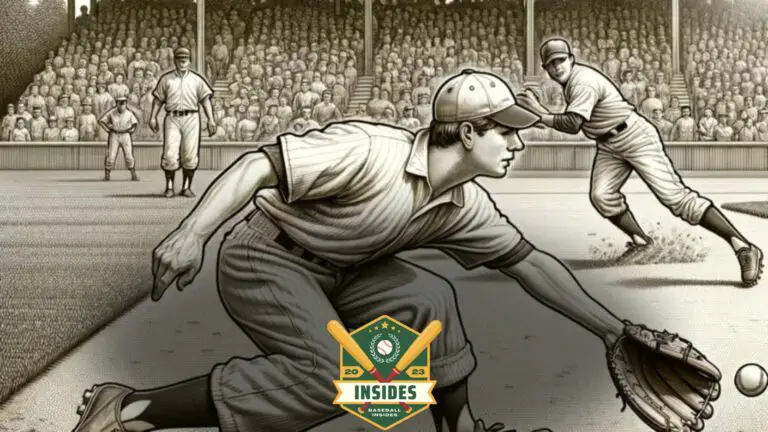
In this article:
Did you ever wonder why Chicago, unlike most cities, is home to not one but two major league baseball teams?
Well, the answer lies in the city’s rich and colorful sports history, its geography, and the remarkable growth of baseball as America’s pastime during the late 19th and early 20th centuries.
Chicago’s two baseball teams—the Cubs and the White Sox—reflect the city’s dual identity, each representing a different side of the city and boasting its unique fan base.
“Baseball is not just a sport in Chicago, and it’s part of the city’s culture and identity.”
The story of how Chicago came to have two baseball teams is fascinating and offers an intriguing glimpse into the historic rivalry that has shaped the city’s baseball landscape.
As a baseball enthusiast or simply a curious reader, you’ll find this tale interesting and informative. So, let’s dive in!
The History of Baseball in Chicago
If you’re a baseball enthusiast, you’d know that Chicago has a vibrant history in the sport. Baseball in Chicago dates back to the 19th century and is rooted deeply in the city’s identity.
Let’s delve into the history of this beloved sport and its significance to the Windy City.
Baseball was first introduced to Chicago in the 1860s by soldiers returning from the Civil War.
The first professional team, the Chicago White Stockings (not to be confused with the later White Sox), began playing in 1870 and joined the National Association, the first professional league, in 1871.
However, the Great Chicago Fire destroyed the team’s ballpark and much of its equipment later that year, forcing them to suspend operations for several years.
When the White Stockings resumed play in 1874, they joined the newly created National League. In the following decades, the team, later known as the Cubs, became one of the dominant forces in the league, winning several championships.
Meanwhile, the American League was established at the turn of the century, and Chicago was awarded a franchise in 1900. This new team, the White Sox, became the city’s second major league baseball club.
Thus began the dual baseball legacy of Chicago. Every season since then, the city’s loyalties have been divided between the North Side (Cubs) and the South Side (White Sox), with each team boasting its own dedicated and passionate fan base.
While exploring the rich history of baseball in the Windy City, it’s fascinating to consider factors like RPI in Baseball and how they influence team performance and rivalries.
The Birth of the Cubs
Ever wondered how the Chicago Cubs came to be? Well, you’re in for an intriguing journey back in time. The story of the Cubs begins in 1870. Yes, you read that right!
The team known today as the Cubs has roots stretching back over 150 years, making it one of the oldest active teams in major league baseball.
The team was initially known as the Chicago White Stockings and was part of the National Association of Professional Baseball Players.
However, in 1876, the National League was formed, and the team became a charter member.
The team underwent name changes, including the Colts and the Orphans, before finally settling on the Cubs in 1903.
Fun fact: The name ‘Cubs’ was derived from the team’s young players, dubbed “Cubs” by the Chicago Daily News in 1902.
Impressive successes marked the Cubs’ early years. They won the inaugural National League pennant in 1876 and followed it up with a series of victories in the 1880s and 1890s.
However, the pinnacle of their early success came in the early 20th century when they won back-to-back World Series titles in 1907 and 1908.
Despite this early success, the Cubs would endure a long title drought, famously going 108 years without a championship, from 1908 until 2016, when they finally secured the World Series title again.
From those early days, the Cubs have continued to evolve, weathering both highs and lows, to become one of the most beloved and iconic teams in baseball.
Their rich history and resilience have cemented their place in the hearts of fans across the globe.
The Rise of the White Sox
While the Cubs were quickly becoming an iconic staple of the Chicago sports scene, the American League was also establishing a foothold in the city.
In 1900, a team formerly known as the Sioux City Cornhuskers was relocated to Chicago and rebranded as the White Stockings, a name that would be shortened to the White Sox just a few years later.
This marked the beginning of a second professional baseball team in the city and the start of a lasting rivalry.
The White Sox enjoyed early success in their new home. In their inaugural season, they topped the American League and won the World Series in 1906, a feat they repeated in 1917.
The team’s founding owner, Charles Comiskey, was instrumental in their success. His dedication to building a strong team and willingness to invest in top talent quickly set the White Sox apart.
However, the White Sox’s reputation would be tarnished by the infamous Black Sox scandal of 1919, when several players were accused of intentionally losing the World Series in exchange for gambling profits.
The scandal shook the baseball world, but the White Sox persevered despite this setback.
Over the coming decades, they would rebuild their reputation and continue to be a driving force in the American League.
The White Sox also made significant contributions to the desegregation of baseball. In 1951, they became the third Major League Baseball team to integrate, signing Minnie Miñoso, a pioneer for black and Latino players.
The team has continued this tradition of diversity, boasting a roster of players from around the world and fostering a fan base that reflects the multicultural fabric of South Side Chicago.
Over the years, the White Sox have showcased some of the greatest talent in baseball history, from Frank Thomas and Harold Baines to Paul Konerko and Mark Buehrle.
Each of these players left an indelible mark on the franchise and contributed to the White Sox’s enduring legacy in Chicago sports.
How Many Baseball Players Are On A Team is a common question that comes up when discussing the composition and strategy of Chicago’s two major league teams.
How the Rivalry Between the Two Teams Began
The rivalry between the Chicago Cubs and the Chicago White Sox, famously known as the “Crosstown Classic,” traces back to the early 20th century.
The roots of this rivalry are intertwined with the history of baseball in the city, with each team seeking to assert its dominance and win the hearts of the local fan base.
Both teams had their first official face-off in the City Series exhibition games starting in 1903.
However, the rivalry’s spark was ignited during the 1906 World Series when the teams had their first meeting in a championship game.
In a surprising turn of events, the White Sox dubbed the “Hitless Wonders” due to their weak batting average, defeated the Cubs, who had dominated that season with a record of 116 wins. This victory by the White Sox further intensified the rivalry.
Another pivotal moment that heated the rivalry was during the 1919 Black Sox Scandal when eight White Sox players were accused of intentionally losing the World Series for monetary gain.
The scandal tarnished the team’s reputation, giving the Cubs an upper hand in public perception, which they capitalized on to increase their fan base.
However, it wasn’t until 1997 that the teams started playing against each other during the regular season, thanks to the introduction of interleague play.
These games, referred to as the “Crosstown Classic,” have become an exciting highlight every season, further fueling the rivalry.
Regardless of the teams’ performance each season, the Crosstown Classic games are always fiercely contested, adding another layer to this century-old rivalry.
The Impact of Comiskey Park and Wrigley Field
The teams don’t solely define Chicago’s rich baseball history but also by the iconic parks in which they play – Wrigley Field and Comiskey Park.
Wrigley Field
Wrigley Field, home to the Chicago Cubs, is known as the “Friendly Confines.” It’s one of the oldest baseball stadiums, opened in 1914.
Its ivy-covered outfield walls, manual scoreboard, and historic charm make it a favorite among baseball fans. But it’s not just the nostalgia that makes Wrigley Field special.
The park’s location in a bustling city neighborhood means fans can enjoy pre- and post-game celebrations in local bars and restaurants.
The traditions of singing “Take Me Out to the Ball Game” during the seventh-inning stretch and flying the “W” flag after Cubs’ victories add to the park’s unique atmosphere.
Comiskey Park
The Chicago White Sox initially played at the old Comiskey Park, which opened in 1910 and is famed for its “exploding scoreboard.”
In 1991, the White Sox moved to a new stadium, now known as Guaranteed Rate Field, but many fans and Chicagoans still refer to it fondly as “Comiskey.”
The park’s South Side location gives it a different vibe than Wrigley Field.
The White Sox have worked hard to improve the stadium’s amenities while maintaining its classic baseball feel.
It’s also worth noting that the fan experience at Comiskey includes the opportunity to enjoy some of the best stadium food in the league.
These parks have undeniably shaped the culture of their respective teams and fan bases. Wrigley Field, with its vintage charm and neighborhood feel, and Comiskey Park, with its blend of old and new elements, represent the distinct identities of the Cubs and White Sox.
These parks are not just places to watch a game; they’re integral to being a Cubs or White Sox fan.
Why the Cubs and White Sox Have Different Fan Bases
Understanding why the Cubs and the White Sox have different fan bases involves taking a deeper look at the history of Chicago’s neighborhoods, social class divisions, and cultural influences.
Each team’s fan base has evolved, reflecting unique influences and characteristics shaping their identities.
The Geographic Divide
Chicago’s geography has played a considerable role in determining the two teams’ fan bases. The Cubs, who play at the iconic Wrigley Field in the North Side, have traditionally drawn fans from the northern parts of the city and the suburbs.
On the other hand, the White Sox, who play in Comiskey Park located in the South Side, have a strong fan base among residents from the city’s southern parts.
The Social Class Influence
Another compelling aspect to consider is the influence of social classes. In the early days, the White Sox were considered the “working man’s team,” with a fan base largely consisting of blue-collar workers from the industrial South Side.
The Cubs, however, were often associated with the white-collar, middle-class fans from the North Side. While these stereotypes have significantly blurred over time, they have negatively influenced the teams’ respective fan bases.
Cultural Influences
Cultural influences have also shaped the fan bases. The Cubs, for instance, have cultivated a nationwide following due to their games being broadcast on WGN nationwide.
The White Sox, on the other hand, has nurtured a more locally-focused fan base. Additionally, the White Sox have a significant Latino fan base, reflecting the demographic composition of the South Side.
Each team’s fan base reflects Chicago’s rich tapestry of neighborhoods, cultures, and classes.
The unique identity of each team and its fans reinforces the city’s diversity and contributes to the vibrancy of Chicago’s baseball culture.
Understanding a Hold in Baseball can give fans deeper insights into the strategic decisions made during games, especially in a city that’s home to two storied franchises.
The Differences Between the Cubs and White Sox Organizations
Understanding the differences between the Chicago Cubs and Chicago White Sox organizations is crucial in fully grasping why Chicago has two baseball teams.
Each team has its unique characteristics, histories, and approaches to the game, contributing to the distinctive flavor of baseball in the Windy City.
Ownership and Management
The Cubs have been owned by the Ricketts family since 2009, while Jerry Reinsdorf has been at the helm of the White Sox since 1981.
These two ownership groups have their unique approaches to running their organizations.
The Ricketts family invested heavily in the Cubs, resulting in a World Series win in 2016.
Conversely, Reinsdorf, who also owns the Chicago Bulls, is known for his commitment to maintaining a stable and steady ship, albeit with fewer championship wins.
Baseball Philosophy and Strategy
The Cubs and White Sox also diverge in their baseball strategy. Under the Ricketts family, the Cubs have preferred investing in high-profile players and a high-octane offense.
This contrasts the White Sox, who, under Reinsdorf, have traditionally focused more on developing their minor league system and building a strong pitching staff.
Stadium and Facilities
Another significant difference lies in their respective stadiums and facilities. Wrigley Field, home of the Cubs, is one of the oldest parks in Major League Baseball and is known for its old-school charm and iconic ivy-covered outfield wall.
On the other hand, Guaranteed Rate Field, home of the White Sox, is a modern stadium with contemporary amenities, reflecting the White Sox’s forward-thinking approach.
Community Engagement
Both teams have strong community ties, but the ways they engage with their fans and community differ. The Cubs have a more national fan base and are known for their high-profile celebrity supporters.
The White Sox, in contrast, have a more local fan base and are deeply rooted in the South Side community, with numerous initiatives aimed at engaging with and supporting this local community.
Ultimately, these differences create a healthy rivalry and diversity in the city’s baseball scene and contribute to the enduring allure of baseball in Chicago.
How Chicago’s Two-Team System Compares to Other Cities
When you think about cities hosting two baseball teams, you might wonder how unique Chicago’s situation is. In reality, Chicago isn’t the only city that boasts two major league baseball teams.
New York City is another example of a city with two franchises: the Yankees and the Mets. Los Angeles also has two, the Dodgers and the Angels. Yet, the dynamics and history of Chicago’s two-team system stand apart in several key ways.
Firstly, Chicago’s baseball history is deeply entrenched, with the Cubs and White Sox dating back to the late 1800s and early 1900s.
While New York and Los Angeles also have longstanding baseball traditions, the formation of their second teams occurred much later.
The Mets were established in 1962, nearly 60 years after the Yankees. Similarly, the Angels were founded in 1961, four years after the Dodgers moved to Los Angeles from Brooklyn.
Secondly, the rivalry between the Cubs and White Sox is distinct in intensity and historical lineage. While the Yankees and Mets, or the Dodgers and Angels, also have their share of rivalry, the passion exhibited by Chicago’s fans is unmatched.
This is arguably partly due to the geographic and socio-economic divisions between the two teams’ fan bases, which are ingrained into the city’s fabric.
These elements add a distinct flavor to the Chicago baseball scene, making it unlike any other country.
Lastly, how the Cubs and White Sox are managed and play baseball also differs from the two team systems in other cities.
Both Chicago teams have unique baseball philosophies, strategies, stadium characteristics, and community engagement efforts.
In contrast, the other cities’ teams often share similar characteristics, with few differences in their approach to the sport and engagement with fans.
Conclusion
Two baseball teams in Chicago are a testament to the city’s deep-rooted love for the sport. The Cubs and the White Sox, each with their unique history and fan base, are integral to Chicago’s cultural identity.
The rivalry between these two teams adds extra excitement to the baseball season, making the sport even more engaging for the fans.
“Baseball in Chicago is not just a sport; it’s a tradition passed down through generations.”
Whether you’re a die-hard fan of the Cubs, loyal to the White Sox, or just a casual observer of the sport, there’s no denying that baseball in Chicago is a unique and thrilling spectacle.
The next time you find yourself in the Windy City during baseball season, catch a game – it’s an experience you won’t want to miss.
Frequently Asked Questions
Why Does Chicago Have Two Baseball Teams?
Due to the historical evolution of the sport, Chicago is home to two baseball teams, the Cubs and the White Sox. The Cubs were established in 1876 as part of the National League, while the White Sox were born in 1901 when the American League was created. The existence of two leagues and Chicago’s status as a major city facilitated the establishment of two teams.
How Did the Rivalry Between the Cubs and the White Sox start?
The rivalry between the two teams began due to the geographical, social, and cultural divides within the city. These differences established distinct fan bases for each team, with the White Sox attracting South Side and working-class supporters and the Cubs drawing fans from the North Side and upper class.
Who Owns the Cubs and the White Sox?
The Ricketts family, through their family trust, owns the Cubs. They acquired the team in 2009. On the other hand, the White Sox are owned by Jerry Reinsdorf, who bought the team in 1981.
Why Are the Cubs and White Sox Fan Bases Different?
The Cubs and White Sox fan bases differ due to geographical, social class, and cultural factors. Traditionally, the Cubs have been the team of the North Side and the upper class, while the White Sox have been associated with the South Side and the working class. Additionally, cultural influences contribute to this division, including differing baseball philosophies and community engagement strategies.
How Does Chicago’s Two-Team System Compare to Other Cities With Multiple Baseball Teams?
Chicago’s two-team system is similar to other cities like New York and Los Angeles, which also have two baseball teams. In these cities, the teams also have distinct identities and fan bases, often reflecting different aspects of the city’s culture and society. However, each city’s baseball history and dynamics are unique.






